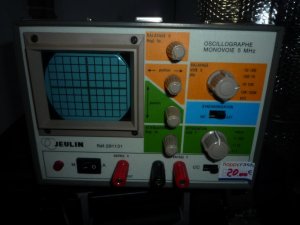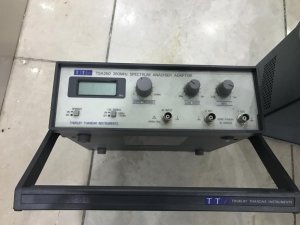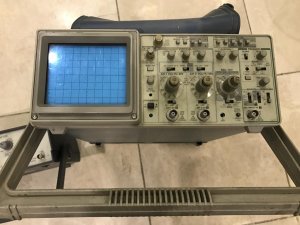Eric, you really don't need a fast scope for most boombox work. A good ol analog scope will work just fine. BTW, a dual trace scope in the 20~30mhz range can be purchased literally for the cost of a cheapo starter boombox. If you can afford a better one, you can do so much more. Our analog audio signals top off at around 20khz. Even on tuners, if you get into oscillators and and IF, remember that AM IF is only 455khz and FM IF (intermediate frequency) is 10.7mHz.
Remember that a scope is really just a visual voltmeter. Imagine this. To adjust azimuth, the goal is to make sure both channels are in phase alignment and you'll want to adjust the azimuth screw so that the L and R channel amplitudes are equal and to max. With a dual trace scope, you can simultaneously view the output signal in terms of volts (amplitude on the waveform). By toggling the azimuth screw, you can see at a glance the relationship between the two traces. If they were both equal in height, then you've got it made. OR if you were to put scope into XY mode (if it has that feature), then you can plot one channel to the X axis and the other channel to the Y axis and a perfect 45 degree upward trajectory would indicate that both X and Y are in proper alignment. In this case, you don't really need to know how many mv is the amplitude (although you can computer it based on the graticle and setting) because the goal is just to equalize or maximize the L and R.
I'm not going to recommend any particular unit or brand but if you do some due diligence in your search, you'll find lots of examples for anywhere from $30 to $100 that should work fine. Just don't buy any where they say "untested" because that literally means it doesn't work and they don't want to say it. If you can afford something a bit more, you'll be much happier with it. Please don't say you can't afford it -- because all you guys need to do is look at your boombox "wall" and you'll know that's not true. It's merely a matter of what you value and prioritize. Anyhow modern scopes not only have automatic waveform capture (which takes a lot of the guesswork out of the settings) but it can also do math. Getting the settings exactly right is the hardest thing for a newbie to learn so automatic waveform capture is a really nice feature. Also, the new digital scopes also will display the voltage, frequency, and you can also compute parts of a waveform by manipulating on screen cursors to map out a portion of a waveform to calculate from. It seems so much more complicated with all these extra "features" but I suspect that you'll find the newer scope actually easier to use once you get familiar with them since you'll probably spend less time playing with the settings like you would with an old school tube. At some point in the (probably near) future, I may offer up the scopes in my tool cache. I think I have a BK 30mhz, and then (3) Tektronix scopes. A Tek 465 100mhz, a 2465 300 (or 400mhz) 4-trace unit, and also one of their digital ones, a dual trace TDS1002B (iirc) 60mhz & 1ghz sampling rate. Due to ease of use, light weight, small footprint, etc, nowadays I use the digital one a lot, even though the 2465 is a whole lot more scope than the digital one and the fast display of the tube vs lcd is much preferable. Still, quick and easy is often preferable and the digital one does that quite well. While researching scopes to buy, you should also research to see if you can find an operator's manual too. Any complicated instrument will be far more valuable to you if you have documentation to go with it, without which no matter how may zillions of features it has, if you can't figure out how to use it, those features will be entirely useless to you. If you are going with a newer scope and it's made by Tek, you can get them far cheaper (although again, cheap is relative) online but just be aware that frequently, used scopes also mean problem scopes. On the other hand, if you get a new one, you'll pay a lot but I think my Tek scope advertised lifetime warranty if you register it with them, don't know if they still offer lifetime warranty or not anymore. For you guys that reside near a technical college that offers electronics engineering programs, you guys might luck out -- lots of students join those programs and pay for the equipments package which is part of the program but then drop out. At that point, they may have like new, or still new instruments but don't need them anymore and you might get them cheap(er) from CL or something.



 :gathering:
:gathering: 
 and after I will study the way to use this tool
and after I will study the way to use this tool
